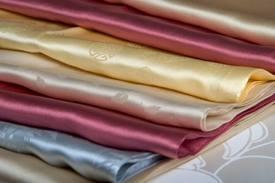BioterrorismKiller silk kills anthrax, other microbes dead
A simple, inexpensive dip-and-dry treatment can convert ordinary silk into a fabric that kills disease-causing bacteria — even the armor-coated spores of microbes like anthrax — in minutes

Treating silk fabrics such as these yields a sporicidal barrier // Source: naver.com
A simple, inexpensive dip-and-dry treatment can convert ordinary silk into a fabric that kills disease-causing bacteria — even the armor-coated spores of microbes like anthrax — in minutes, scientists are reporting in the journal ACS Applied Materials & Interfaces. They describe a range of potential uses for this new killer silk, including make-shift curtains and other protective coatings that protect homes and other buildings in the event of a terrorist attack with anthrax.
An American Chemical Society release reports that Rajesh R. Naik and colleagues explain that in adverse conditions, bacteria of the Bacillus species, which includes anthrax, become dormant spores, enclosing themselves in a tough coating. These spores can survive heat, radiation, antibiotics and harsh environmental conditions, and some have sprung back to life after 250 million years. Certain chemicals — most popular among which are oxidizing agents, including some chlorine compounds — can destroy bacterial spores, and they have been applied to fabrics like cotton, polyester, nylon and Kevlar. These treated fabrics are effective against many bacteria, but less so against spores. The researchers tried a similar coating on silk to see if it could perform better against these hardy microbes.
They developed a chlorinated form of silk, which involves soaking silk in a solution that includes a substance similar to household bleach and letting it dry. Silk treated for just an hour killed essentially all of the E. coli bacteria tested on it within 10 minutes and did similarly well against spores of a close anthrax relative used as a stand-in. “Given the potent bactericidal and sporicidal activity of the chlorinated silk fabrics prepared in this study, silk-Cl materials may find use in a variety of applications,” the authors say. Other applications, they add, include purifying water in humanitarian relief efforts and in filters or to mitigate the effects of toxic substances.
— Read more in Matthew B. Dickerson et al., “Sporicidal/Bactericidal Textiles via the Chlorination of Silk,” ACS Applied Materials & Interfaces (21 February 2012) (DOI: 10.1021/am2018496
